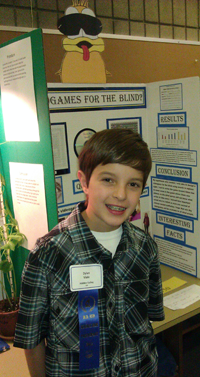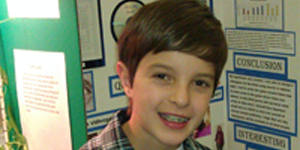Success Story: A Video Game for the Blind
Dylan Viale's fifth-grade science project gave him a chance to share something he enjoys with his grandmother, who is blind. Designing his first video game ever, Dylan created Quacky's Quest, a maze game you don't have to see to play!

For his fifth grade science project, Dylan Viale (pictured above) used GameMaker to create a sound-based video game to share with his grandmother, who is blind. The project gave Dylan a firsthand look at what's involved in video game design, and his classmates got to try out his maze game—blindfolded. Read about other student science successes in the Science Buddies in Action area.
As a fifth grader at Hidden Valley Elementary, Dylan had the option of doing a book report or a science project. Having explored both adhesives and ant repellents in science projects during the third and fourth grade, he again opted for a hands-on science exploration. This year, however, he pursued a topic that has both personal and social significance. Dylan wanted to see if he could design a video game that someone who is blind or has vision problems can play and enjoy. "I chose this project because I enjoy playing video games, and even though my grandmother has given me video games as birthday and Christmas presents, she has never been able to play the games since she cannot see them," explains Dylan. "I wanted to see if it [is] possible for a blind person to play video games."
Dylan's interest is both empathetic and inventive, and his project required him to put himself into the position of a blind gamer to better understand the issue. A typical video game involves both sight and sound, but it is possible to play many games even with the sound off. If you can see the game, you can still play. Dylan's project flips this around and asks whether or not being able to "see" a game is a required component in designing a game. "My science project was to see if I could design a video game for the blind using sound to replace sight," explains Dylan. By stepping back and questioning what actually "makes" a game, and what relationship sight and sound have to game play, Dylan immersed himself in game design issues, ones he hadn't necessarily considered when he was simply playing games for his own entertainment. You can mute the volume and still play, but what happens if you close your eyes and just listen?
Designing His First Video Game
Dylan hypothesized that if sound is used correctly within a game, then it is possible to create a game that a blind player can successfully play—and enjoy. "Because the video games that I play have sound in them, I thought that if I just put the sounds in the right places, a blind person would be able to move around." Building on that premise, Dylan took his first steps in video game development and design.
Dylan had not done any game programming before, but with his the goal of creating a sound-based video game in mind, he began researching his options for development. Based on resources at Science Buddies that suggest GameMaker as a creation tool for student video game projects, Dylan downloaded and installed GameMaker, worked through the tutorials, and began designing Quacky's Quest, a maze-oriented game that built upon his love of real-world hay mazes.
The 'Sound' of a Video Game
Developing a first video game can be challenging enough, but when your first game is one you hope will be playable both with and without being able to see the screen, the project takes on added complexity. Dylan, however, was up to the challenge. "I learned how much time and how many steps it takes to design a video game," he explains, "like creating sprites and making rooms and objects in a game." As Dylan quickly discovered, "programming a game is a lot of work, and every piece in the game requires a command, even an empty room."
In Quacky's Quest, "the goal is for the player to guide Quacky (the character in the game) through three different mazes to find the golden egg in the final room. Quacky follows a trail of diamonds and tries to avoid spiders and dynamite which happens when you go the wrong way," explains Dylan. From the description, you can imagine what the game looks like. But Dylan was determined to make a maze someone can navigate based on sound alone.
It's harder than it sounds! "Even one second of silence caused confusion," says Dylan. During early testing, he realized that it is easy to overlook places where sound cues are needed. "When I tested the game with my grandmother, [we] found that it had a serious problem," recalls Dylan. "Once she collected the diamonds in the game, there was no more sound. If she got confused in the maze and started getting lost, she [had] no way of knowing where she was going."
"I was surprised how much work it was to design the game," says Kelly Viale, Dylan's mother. "It was very involved (at least for a 10 year old). I was also surprised that when he came across a challenge in designing the game, he didn't want to quit."
Dylan went through several rounds of troubleshooting and tweaking to eliminate areas of confusion and to strengthen the sound cues in Quacky's Quest. To address some of the challenges that arose, he had to really think outside the box. For example, adding additional game elements behind Quacky as he moved forward in the maze helped solve a problem Dylan had observed when his grandmother tested an early version. "I had to program the game to drop boulders behind Quacky as he progressed through each maze, so that when she went backwards, it would make the negative sound of hitting a boulder or a wall."
A Winning Project
The project was harder than Dylan expected, but, in the end, he succeeded in developing a sound-guided game. His project won first place at his school science fair, and he went on to exhibit at the district fair. Quacky's Quest also earned Dylan the admiration of his classmates and teachers—and may have piqued curiosity about game design among other students. From Kelly's perspective, Dylan's project shows that when a gaming project is tied to the scientific or engineering process, the experience can have great value. Dylan's teacher, Mrs. Sullivan, was also supportive of Dylan's project. Though she encouraged the technical and engineering side of the project, she also pushed for him to follow the scientific method and test the game with blindfolded players so that he could gather data about the game. During this process, Dylan discovered that blindfolded players were actually slower at the game than his blind grandmother, who is used to taking cues from sound. "Sighted people were so used to using their eyes to play a game that it took them much longer to focus on the sounds," says Dylan.
"Dylan's project has created quite the interest at school," says Kelly, noting that more than a third of his classmates asked for a copy of their own to play at home. "I think that it is wonderful that this type of project teaches the kids how things work and that they have the ability to design a game," says Kelly.
For Dylan, the ultimate reward was personal. "The best part of the project was watching my grandmother actually play a video game," says Dylan. "I hope that one day video games will be available to all blind people."
Dylan has a number of interests, including karate, hiking, soccer and building with LEGO. While being a LEGO engineer currently makes his list of possible career paths, his first video game project has definitely sparked new interest.
Explore Coding Projects
For related video and computer game resources, see the following:
- Creating a Video Game for the Blind
- Kid-Friendly Programming Languages and Resources
- Success Story: The Science of Video Games
- Video & Computer Games Project Ideas
Categories:
You Might Also Enjoy These Related Posts:
- Making Recycling Sorting Machines—STEM Success
- Mini Trebuchets and a NM MESA Challenge
- Helping Students Build Coding Skills with Drones and Self-Driving Cars
- Middle School Student Codes to Improve Life with Visual Impairment
- Student Science Project - Designing and Coding a Video Game to Help People with Alzheimer's
- Teacher Combines Computer Science and Engineering Design for Middle School Students - STEM Success Story
- A Mirror Maze Success Story
- Paper Roller Coasters and Energy Transformation: STEM Teacher Success Story










